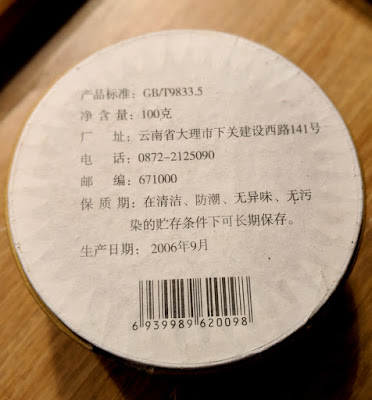Because this is a quick and mostly unplanned write up, the photos I have were taken with my phone while most of the other photos on my blog were done with a Canon digital camera.
 |
| 2006 Xiaguan Jia Ji sheng tuo |
 |
| 2006 Xiaguan Jia Ji sheng tuo |
 |
| 2006 Xiaguan Jia Ji sheng tuo |
This is a common sheng tuo made every year by Xiaguan Tea Factory. They are 100g in size. The wrapper states that it is "Jia Ji" (甲級) or "Grade A," and I usually see these sold in the green boxes, although Xiaguan does sell other teas in similar boxes, some of which are also green. This one here is from 2006, and I purchased it from Crimson Lotus tea who says it was stored in humid Guangzhou in southern China.
 |
| 2006 Xiaguan Jia Ji sheng tuo |
Xiaguan tuos are very heavily compressed. My understanding is that some time around 2005-ish (maybe?) they started imprinting the side of the tuos with this seal. Such tight compression can affect how the tea interacts with the atmosphere since air doesn't readily flow between the leaves. Although this is over 10 years old and has been stored in a humid province of China, it still retains some greenness. Compare this though to the one below which is from 2014 (photographed in 2015) which is greener and the tea buds have more silver color to them instead of light brown.
 |
| 2014 Xiaguan sheng tuo (photographed in 2015). |
The tight compression of these tuos makes them difficult to break apart without breaking most of the leaves. When these Xiaguan Jia Ji tuos are young they can be fairly bitter if not brewed carefully. A lot of that is due to the source material used, but I think having a lot of broken leaf will also contribute to bitterness since those smaller leaf pieces will brew stronger in the same amount of time that larger intact leaves can. It's important to not use too much leaf when these are young and to be careful with the infusion times. But what about when they have over 10 years of age?
 |
| 2006 Xiaguan Jia Ji sheng tuo |
I broke off about 5g and brewed it in a 75ml gaiwan with boiling water. My first infusions were only a couple seconds long. Unlike the 2014 version which brewed up an orange-yellow when I had it in 2015, the 2006 version brews up a beautiful clear vibrant orange. The liquor has very impressive mouthfeel that is thick, oily, and slick in texture. Some astringency is present, but it's mild and it's the pleasant kind that stimulates the mouth and makes you salivate.
 |
| 2006 Xiaguan Jia Ji sheng tuo - leaf looks a little greener in the photo than it did in person. |
The taste is also quite impressive. It does retain some of the coriander savoriness that I remember in the younger version, but it's deeper and more rounded. The savory profile is not as forward and is surrounded by a sweetness followed by old book and leather notes. The sweetness is a real nice surprise and can even be mouth watering at times. This was said to be stored in a humid environment, but the tea does not taste musty. This is likely a combination of the tight compression and the Xiaguan storage box which help to stabilize the ambient factors.
Later steeps reveal some apricot flavors, and when pushed hard, the tea can still provide some bitterness, but it's balanced out by an increase in leather intensity and orange citrus. Generally speaking I did not feel that I had to be extremely careful when brewing this one. The classic Xiaguan smokiness is present, but not dominating. It comes through in the aftertaste with some of the leather notes to create a nice fresh tobacco leaf profile.
I should also mention that although the age has mellowed out some of the harsh edges that this tea can have, the energy is still quite present. I may regret drinking this so late on a weeknight when I have to wake up early tomorrow!
Overall I am very impressed with this tea especially after having the 2014 version a couple years ago, and I'm also wondering how much better this could be with even longer age in the correct environment. It's an example of how a cheap sheng can transform into something good with time. When these are new they cost about $5. Although I'm just now drinking it for the first time, I bought this 2006 one for $26 back in 2015, and it seems that Crimson Lotus still has them in stock and have not raised the price. At this price that comes out to $0.26/g which is equivalent to a $93 standard size cake (357g). Depending on where you buy your semi-aged tea, $0.26 is a pretty good sweet spot where you can usually find very drinkable and enjoyable tea so this tea does have some competition, but I feel like the price is fair, especially for anyone not willing to navigate away from Western facing vendors to find other deals. And again, it would be interesting to see how this tea would be with another 10 years or so of age on it if the storage was good, but I can say that about a lot of teas.
Thank you for reading. This post does not necessarily mean that I'm going to start posting regularly again, but who knows! I'll try to write when I think of anything that might be interesting.
Crimson Lotus website: https://crimsonlotustea.com/


































